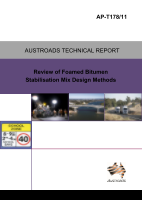Pavement

Review of Foamed Bitumen Stabilisation Mix Design Methods
- Publication no: AP-T178-11
- ISBN: 978-1-921709-77-7
- Published: 22 June 2011
- PDF (free) Download
Austroads Project No: TT1358: Review of Structural Design Procedures for Foamed Bitumen Pavements proposed a method for the thickness design of foamed bitumen to be adopted in principle by Austroads. Foamed bitumen is a mixture of hot bitumen, water and air. For instance, in Queensland typical quantities are 97.5% bitumen, 2% water and 0.5% foaming agent. The foaming agent is added to improve the quality of the foam. When hot bitumen (160 to 200 °C) comes in contact with cold water (15 to 25 °C) the mixture expands to greater than 10 times its original volume and forms a fine mist or foam.
- 1. INTRODUCTION
- 1.1. General
- 1.2. Selected Mix Design Methods
- 1.2.1. South African Methods
- 1.2.2. Queensland Department of Transport and Main Roads Method
- 1.2.3. Austroads Pavement Technology Series
- 1.3. Purpose for Characterisation of Materials
- 2. MATERIAL PROPERTIES
- 2.1. Bitumen Foaming Properties
- 2.1.1. Austroads
- 2.1.2. Queensland Department of Transport and Main Roads
- 2.1.3. Asphalt Academy
- 2.2. Aggregate Properties
- 2.2.1. Particle Size Distribution
- 2.2.2. Aggregate Plasticity
- 2.2.3. Secondary Binders
- 2.2.4. Aggregate Angularity
- 2.2.5. Aggregate Durability
- 3. MIX DESIGN
- 3.1. Aggregate Preparation
- 3.1.1. Queensland Department of Transport and Main Roads
- 3.1.2. CSIR Transportek and Asphalt Academy
- 3.2. Bitumen Content for Trial Mixes
- 3.2.1. Austroads
- 3.2.2. Queensland Department of Transport and Main Roads
- 3.2.3. Asphalt Academy
- 3.3. Secondary Binder Contents
- 3.4. Moisture Content for Trial Mixes
- 3.4.1. Queensland Department of Transport and Main Roads
- 3.4.2. Asphalt Academy
- 3.5. Mixing and Compaction
- 3.5.1. Austroads
- 3.5.2. Queensland Department of Transport and Main Roads
- 3.5.3. Asphalt Academy
- 3.6. Laboratory Curing Conditions
- 3.6.1. Austroads
- 3.6.2. Queensland Department of Transport and Main Roads
- 3.6.3. Asphalt Academy
- 3.7. Design Binder Content Determination
- 3.7.1. Austroads
- 3.7.2. Queensland Department of Transport and Main Roads
- 3.7.3. Asphalt Academy
- 4. DISCUSSION
- 4.1. Foaming Water Content
- 4.2. Materials Suitable for Foamed Bitumen Stabilisation
- 4.2.1. Varying Requirements with Traffic Loading
- 4.2.2. Aggregate Grading
- 4.2.3. Plasticity
- 4.2.4. Aggregate Durability
- 4.2.5. Aggregate Angularity
- 4.3. Quantity and Type of Secondary Binder
- 4.4. Test Sample Compaction
- 4.5. Sample Curing
- 4.6. Strength/Stiffness Characterisation Tests
- 5. SUMMARY AND RECOMMENDATIONS
- REFERENCES
- APPENDIX A PROPOSED REVISION TO AUSTROADS GUIDE TO PAVEMENT TECHNOLOGY
Related publications
Latest Pavement News
